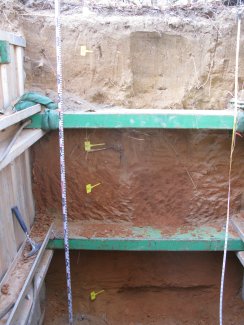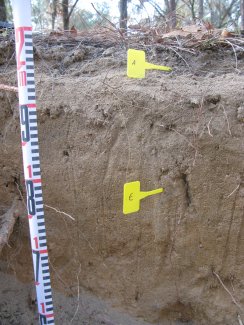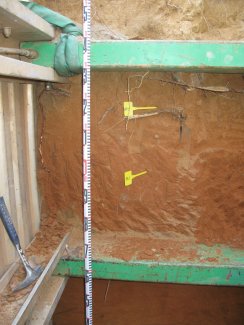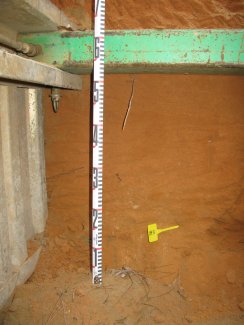The Jones Center At Ichauway NEON (JERC) Soil Descriptions
Distributed Soils Reports
Pedon Descriptions
Pit‐level observations and field measurements reported using the standard NRCS format. They contain volume estimates for coarse fragments > 20 mm where applicable.
Site Level Plot Summary
A narrative summary that places the sampled soil pedons in the broader context of soils and geomorphology for the entire NEON site.
Megapit Images

D03 JERC megapit soil profile 0-200 cm

D03 JERC megapit soil profile 0-41 cm

D03 JERC megapit soil profile 48-162 cm

D03 JERC megapit soil profile 132-200 cm
Megapit Pedon Description
| Print Date | Jul 22 2015 |
|---|---|
| Description Date | Dec 10 2012 |
| Describer | Ken Monroe |
| Site ID | S2012GA007002 |
| Pedon ID | S2012GA007002 |
| Lab Source ID | KSSL |
| Lab Pedon # | 13N0259 |
| Soil Name as Described/Sampled | Lucy |
| Classification | Loamy, kaolinitic, thermic Arenic Kandiudults |
| Pedon Type | representative pedon for component |
| Pedon Purpose | research site |
| Taxon Kind | series |
| Associated Soils | Norfork, Orangeburg, Troup, Wagram |
| Geomorphic Setting | on summit of interfluve of ridge on upland on coastal plain coastal plain |
| Upslope Shape | convex |
| Cross Slope Shape | convex |
| Particle Size Control Section | 68 to 118 cm. |
| Description origin | NASIS |
| State | Georgia |
| County | Baker |
| MLRA | 133A -- Southern Coastal Plain |
| Soil Survey Area | GA603 -- Baker and Mitchell Counties, Georgia 7-TIF -- Tifton, Georgia |
| Map Unit | TwB -- Troup sand, 0 to 5 percent slopes |
| Quad Name | Hopeful, Georgia |
| Std Latitude | 31.1960694 |
| Std Longitude | -84.4664694 |
| Latitude | 31 degrees 11 minutes 45.85 seconds north |
| Longitude | 84 degrees 27 minutes 59.29 seconds west |
| Datum | NAD83 |
| UTM Zone | 16 |
| UTM Easting | 741407 meters |
| UTM Northing | 3454097 meters |
| Primary Earth Cover | Grass/herbaceous cover |
| Secondary Earth Cover | Intermixed conifers and hardwoods |
| Existing Vegetation | broomsedge bluestem, longleaf pine, turkey oak, wiregrass gentian |
| Parent Material | loamy marine deposits and/or sandy marine deposits |
| Description database | KSSL |
| Diagnostic Features | ochric epipedon 0 to 68 cm. kandic horizon 68 to 203 cm. argillic horizon 68 to 203 cm. |
| Slope (%) | 2.0 |
| Elevation (meters) | 45.7 |
| Aspect (deg) | 90 |
| MAAT (C) | 27.2 |
| MWAT (C) | 11.1 |
| MAP (mm) | 1,312 |
| Drainage Class | well |
| Horizon Details |
A--0 to 8 centimeters (0.0 to 3.1 inches); grayish brown (10YR 5/2) sand; weak fine granular structure; loose, very friable; very fine roots and fine roots; abrupt smooth boundary. Lab sample # 13N00561 E--8 to 68 centimeters (3.1 to 26.8 inches); yellowish brown (10YR 5/4) oxidized sand; single grain; loose, loose; medium roots and fine roots; clear smooth boundary. Lab sample # 13N00562 Bt1--68 to 105 centimeters (26.8 to 41.3 inches); brown (7.5YR 4/4) oxidized sandy loam; weak medium subangular blocky parts to weak fine subangular blocky structure; slightly hard, friable; medium roots and coarse roots; gradual wavy boundary. Lab sample # 13N00563 Bt2--105 to 185 centimeters (41.3 to 72.8 inches); yellowish red (5YR 4/6) oxidized sandy clay loam; weak medium subangular blocky structure; slightly hard, friable; medium roots; gradual wavy boundary. Lab sample # 13N00564 Bt3--185 to 203 centimeters (72.8 to 79.9 inches); reddish brown (5YR 5/4) oxidized sandy loam; weak fine subangular blocky structure; slightly hard, friable; . Lab sample # 13N00565 |
Credits: This megapit soil pedon description was generously created by USDA Natural Resource Conservation Service staff, with particular thanks to Larry West, Jon Hempel, and numerous field staff.